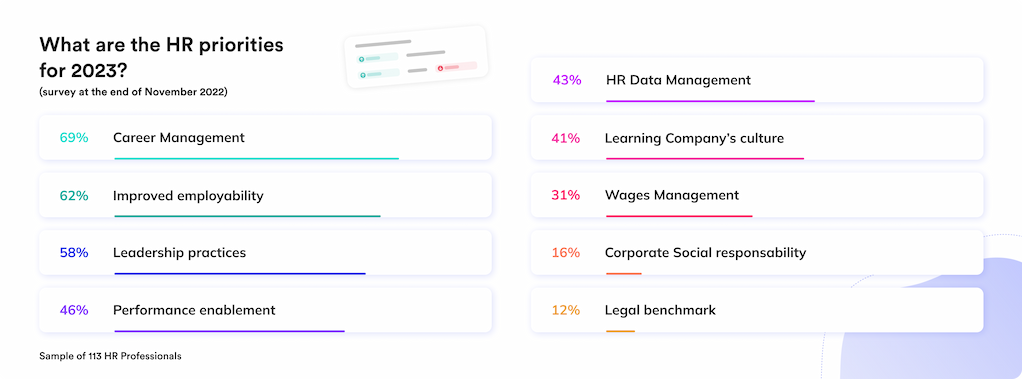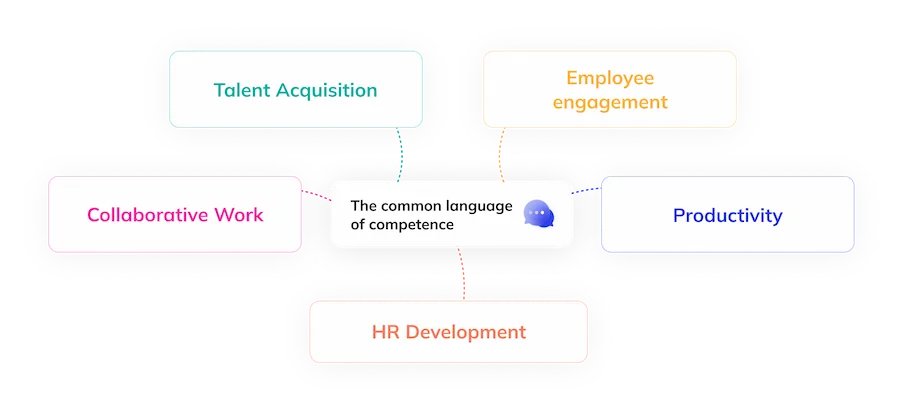After two dense years for the HR professionnals, what are the main upcoming HR challenges to tackle?
A BCG and ANDRH survey shows that 60% of executives see a growing influence of HR in the coming years. Now, it’s time to take advantage of this new reality to move from a “reactive” mode to an “anticipatory” model.
Now, it’s time to take advantage of this new reality to move from a “reactive” mode to an “anticipatory” model diversity and inclusion, and the facilitation of new ways of collaborating will take on a greater role. Having completed the 2022 retrospective, we can now look forward to the HR challenges for the near future.
The upcoming years will be challenging for leaders.
How to maintain business performance when it becomes necessary to rationalize both human and financial resources?
In a context where the imperative is to do better with less, the company’s skills will be top of mind.
What are the 3 growing HR priorities?
We believe that the 3 HR priorities will focus on the following topics:
- Mobilizing skills and internal skills
- Providing the organization with superior adaptive skills
- Optimizing the digital transformation and gaining expertise
Our reflection is based on both a survey of 113 HR team members and a synthesis of several sources including the Gartner study. You’ll find both a summary of the trends in these reports, plus the opinions of the HR teams surveyed.
HR Priority #1: Mobilizing internal skills and motivation
Among the most frequently cited issues in our 2023 study, career management and employee employability are at the top of the list with 69% and 57% respectively. Shaping careers that meet talent expectations and business needs is the number one priority.
PWC has evaluated the mismatch between skills and the French economy at nearly 3 billion dollars. How can this employability be improved?
1. Renewing the answers to the shortage of skills
The skills shortage will continue into 2023 and beyond. What factors are driving the shortage at skills?
- A record number of resignations peaking since the end of 2021. It is often the most valuable skills that leave the company.
- The individuals with the scarciest skillset, often digital, tend to choose freeancing
- Recruitment is considered increasingly difficult
It’s clear that the use of recruitment agencies, social networks and programmatic recruitment are reaching their limits. In parallel to this shortage,a gap is growing between the approach of skill, which remains uncommon in most companies, and the Jobs & Skills Management, a formal and regulatory framework, and the day-to-day challenges that require greater reactivity. The year 2023 will therefore see the advent of pragmatic management of skills and, for the most agile companies, the birth of a new organizational structure.
What organizational principles do the most successful companies use?
- Fixed roles or jobs are progressively disappearing to the leave the floor to the aggregation of skills to carry out the company’s activity.
- Skills and potential take precedence over experience and qualifications to allocate resources that have become volatile.
As is often the case in HR, leadership support, budget and challenging habits will be key to initiating the necessary changes.
2. Consider motivation in career management
How did we manage to combine so many simultaneous challenges? Talent attraction and motivation figures have never been lower. Hasn’t appetite for certain tasks ans skills been too neglected in career management? We think so.
For several years, HR investments have been partly dedicated to working conditions that promote employee well-being. We can boast 80% of employees saying they are “happy at work”, but this has not prevented turnover from rising from 13.7% to 15. 1% in the same period. The intensity and sustainability of their involvement is based on something else: the satisfaction generated by the activities of the job itself, and, to a lesser extent, the interpersonal relationships.
How to define motivation?
Motivation is a natural tendency by which an individual successfully mobilizes one or several of their resources while inducing a feeling of pleasure.
This concept may seem abstract, even ideological. It should not overshadow the level of skills and experience in recruiting or designing mobility, but it should be an integral part of the system for building the career paths offered by the company.
On average, individuals will switch careers 5-7 times throughout their working lives. Approximately 30% of the entire workforce will now change jobs every 12 months, as per data from the U.S. Department of Labor. Companies must adapt to their decision matrices:
- The “working conditions” component.
- The “business” component.
- The “interpersonal relations” component.
- The “nature of tasks content” component.
This is why we insist on the importance of knowing the skills of candidates and employees when developing career plans.
In a context of optimization of resources and budgets, the skills have two other significant assets:
- They create bridges between relatively different professions.
- They accelerate memorization and learning. Training on skills which represent a source of satisfaction is the HR development scheme to be favored.
3. Adopt the common language of business performance: the skill
The raison d’être of the company, its performance, is today undermined by two phenomena.
- First of all, the mismatch between skills and the needs of companies. According to Capital magazine, this central economic problem stems from a misdirection of talent towards the fields and careers that contribute to workers’ productivity.
- Secondly, the job-centered organization is obsolete the job-centered organization. Indeed, the formal nature of job descriptions does not fit to the reality of managers. In addition, the evolution of functions is subject to constant changes in know-how, essentially technical.
A major challenge to come is to structure the HR approach around a common nomenclature, that of skills. We believe that it is the best way to respond to productivity needs, recruitment issues, commitment and collaborative work.
How can we get this common nomenclature adopted?
Today, 58% of companies have a directory of each of the skills : the repository. The difficulty is not in creating it, but rather in getting it adopted. The companies must not use repositories to establish salary scales and manage career development. On the contrary, the notion of skill is integrated into the employee’s profile from the moment he or she is on-boarded and in each of his or her actions. Each of the company’s opportunities, whether it be mobility, a short-term project, the construction of a career plan or a training suggestion, is fed by the common base represented by all the company’s skills categories.
As a result, HR’s topmost focus will revolve around organizing and strategizing skill sets that facilitate the incorporation of this shared language. By identifying, nurturing, and customizing these skills, the company can effortlessly realign its workforce towards a flexible outlook.
Here are additional resources on this first HR priority:
- Individualize career management
- The organizational model around the skills
- Successful internal mobility: instructions for use
HR Priority #2: Providing the organization with greater flexibility
The perpetual need for adjustment and the corresponding demands of change management have taken a toll on the motivation of both managers and their teams, leaving them drained and causing a disruption in their collaborative efforts. It appears that the only viable solution to cope with these circumstances is to implement some form of reorganization, be it at an organizational or cultural level, every other year. However, instead of merely accepting this constant state of unpredictability, we can cultivate a sense of natural empowerment among our staff, bringing it closer to the ground level. What if embracing uncertainty didn’t have to entail embracing it as an opportunity, but rather as a challenge to be met head-on?
1. Accepting uncertainty
Is uncertainty a more pervasive force in the present compared to the past? Our stance is that it is not the prevalence of uncertainty that has changed, but rather our perception of it. We tend to falsely pursue control as a means to gain visibility, disregarding the potential for a collective bonding experience brought on by shared risks within the company. This pursuit of control ultimately impedes the cohesion and solidarity that such shared risk factors could potentially provide to the company.
If it is neither possible nor desirable to eliminate these external factors, what about the factors internal to the company? To respond to uncertainty, a company like VINCI has adopted a decentralized organization advocated by its CEO, Xavier Huillard. Based on trust and the “inverted pyramid”, this organization has encouraged innovation and creativity among employees in order to better understand the constraints.
The usual responses to economic downturns, such as the one we will experience in 2023, are often to limit autonomy and increase reporting. We are convinced that being adaptive is not only an organizational issue but also a cultural one.
2. Arm ourselves to adapt to tomorrow’s jobs
During our Webinar focused on the sustainability of skills on September 29th, several issues were raised by the 80 participants:
- Anticipating news skills
- Limiting the loss of skills
As a central HR planning mechanism, Jobs & Skills Management has both strengths and limitations. It succeeds in identifying the loss of skills resulting from employees retiring, but it struggles to highlight the emerging skills and too often conceals the impact of internal development wishes.
What are the tools for adapting to changes in the professions?
Reckoning employee aspirations
We are becoming aware of the treasure trove of employees’ aspirations to identify the skills and professions they are attracted to. Structuring the Jobs & Skills Management approach with these elements, collecting them and seeing their evolution help us to envisage the jobs where attrition will be low and those towards which there will be more desertification.
The transversal skills
Defined as assets that can be mobilized in several roles and several sectors, the cross-functional skills are highlighted in the high-potential programs of large companies. The internal mobilities that will last can be based on the transversal faculties of several individuals and cultivated by the HR development policy of the company.
The Strategic Workforce Planning
Being agile in times of change takes preparation, yet today resource planning is, for 51% of companies, a single issue of number of people or “FTE” (source Gartner 2022).
On a day-to-day basis, workshops follow one another to define staffing forecasts in terms of volume and to qualify the impact of transformations on employment and skills. Far too much time is spent on developing a vision of the existing situation and compiling data; this is what undermines the use of the major HR tool that the SWP represents.
In a context where there will be a potential freeze on recruitment and its impact on the maintenance of strategic skills, the risk of departures caused by the scarcity of opportunities for internal evolution, it will no longer be possible to continue like this. Having a snapshot of the skills projections to be passed on due to retirements, opportunities for redeployment of resources, potential empty chairs in key functions, is achievable with a SWP tool.
C. Widespreading the use of HR data
HR data management is one of the 3 challenges for 48% of our panel of respondents. Priorities are still given to securing and protecting the confidentiality of data before using it for decision making. However, the tightening of companies’ room for maneuver implies the use of a reinforced HR management control. But that’s not all, the gap is widening between expectations and the actual skills Data of the company; it is the role of the HR team to be trained on this field and to maintain the employability.
The Data invites itself in many professions
Our October 20th webinar, “Integrating Data into your business“, in partnership with The Wagon for business, reveals that data analysis skills and exploitation are no longer the sole preserve of data scientists. The treasury and finance businesses see data skills increase by 76% between 2021 and 2022, purchasing by 44%.
It is not only a question of technical skills but also of soft skills, in this case we associate the phenomenon of data literacy (acculturation to data) with faculties such as :
- Communicating with impact
- Cooperating across-the-board
- Learning to learn
Having made this observation, it is now essential to provide the means to make sure that targeted populations acquire these skills. Artificial intelligence makes it possible to exploit the differences in skills to formulate training recommendations adapted to each individual. The upcoming years will see major reskilling campaigns, particularly on this Data dimension.
Data acculturation of the HR roles
Several elements make the HR role the legitimate repository of company data. First of all, the legal indicators to be provided to the administration are more and more numerous, and the quantity of anonymous HR data is considerable:
- Team performance data
- Health and stress data
- Data focused on pay and benefits elements
- Data from skills, experience and career path
- ….
However, as Arnaud Coulon, HR Data Expert at Sopra Steria Next, mentions in his blog, mypeopleanalytics, the Human Resources function has a unique role to play. Indeed, it still needs to develop its own capacity to make its data reliable, protect it, share it and make the most of it. At the same time, it is a key player in developing the skills of the entire organization on Data topics. There is therefore a double challenge to be met to support the company in an efficient and informed use of particularly sensitive data.
Implementing HR data governance defines the rules and processes related to HR data management. It provides a space to ensure that data is consistent, reliable, secure, used correctly and compliant.
The HR role finds itself in a situation of mandatory acculturation. Understanding individual preferences, whether on learning methods or behaviors towards collaborative work, requires an effort from the role and tools that make them want to dive deeper into the subject. The validity of the data, the cleanlyness of the database, is a challenge that the department faces. The versatility of the role will, once again, be able to express itself within the framework of its tools, and in particular that of its HRIS.
Here are additional resources on this second HR priority:
- The solutions of Strategic Workforce Planning
- Promote cross-cutting skills
- How to make your HR data more reliable?
HR Priority #3: Streamlining HR tools
Markess counts 600 HR solutions in its latest study, and the digital solutions experts believe that this offer will continue to expand. In this environment where six players have 30% of the market share, the inflation of the offer is both an opportunity to benefit from highly specialized solutions but it also represents a lack of readability for HR teams.
The upcoming years will be marked by rationalizing HR tools, as well as giving a special attention to software interoperability. Finally, the performance criteria for these tools will shift towards the experience of users who are now a priority: employees and managers.
1. Involving users
HR teams need to free up time to focus on employee retention, resource planning and strategic skills development. As a result, since 2007, HR information systems have become more employee-centric, or “self-service“. Talent management software aims to empower employees; the progressive integration of artificial intelligence, machine learning facilitate the understanding of individual preferences, user experience and frequency of use. It is also worth noting that this trend addresses the need to improve the HR sphere, which is now the responsibility of managers.
How to facilitate the adoption of an HR application?
Users want to find in their business tool the same experience as in their personal sphere. This means being able to access synthetic information in a minimum of time, to keep track of interactions and performances and to synchronize them with all the modules (objectives, skills, training, annual interview).
According to the equipment of the collaborators we also note the increasing use of the mobile devices, certain functionalities become essential:
- Preparing for interviews
- Selection of internal positions or projects in a dedicated area
- Engagement questionnaires
- Micro-training
All these best practices allow us to consider adoption rates close to 80% depending on the initial digital culture of the company.
2. Eradicating application compartmentalization
Whether they are SMEs or large groups, companies need to have an unified environment, to avoid application overload. Very specific solutions still have a bright future as long as they can be integrated into a coherent ecosystem. Driven by this user need, software is moving towards interoperability, whether made possible by APIs (application programming interfaces) or directly within an HR application marketplace.
The next few years will see the development of interconnected suites composed of more or less specialized solutions that HR professionals will build themselves. The progressive decompartmentalization of HR applications will also help meeting the challenge of HR data homogeneity, a mandatory asset for the proper use of dashboards.
3. Evaluating the benefits
According to our partner Tempo&Co, change projects in companies have increased threefold over the last 20 years. The problem: the time allocated to these projects has been divided by 2.
For 3 years now, we have been observing a strengthening of the change management methodology. Delivering the expected promises requires bringing together internal stakeholders, the publishing partner and a consulting firm.
The fatigue of permanent changes observed in companies pushes HR departments to better define the objectives, preparation, implementation of change and measurement of the benefits derived.
What are the indicators of success for an HRIS project?
- Legal compliance
- Efficiency in organizational planning
- Consistency and ease of use of HR data
- The answers to business objectives around the adaptation of skills
Your additional resources on this third HR 2023 priority:
- HRIS: developments and prospects for digital HR tools
- Neobrain and the SAP ecosystem
- Involve employees in their HR tool
HR issues for a sustainable transformation
To summarize, the economic slowdown in 2023 presents an opportunity to capitalize on our company’s intrinsic assets. Instead of shying away from uncertainties, we should embrace them and explore the use of arbitration levers, such as recruitment, mobility, and external services.
With limited resources, we must search for optimizations and restructure tasks based on mobilizable assets. Identifying, valuing, and mobilizing talent is crucial for developing upskilling and reskilling plans that meet the needs of our business transformation. However, the way we address these challenges is just as important as the challenges themselves.
As the HR function gains more prominence in a complex world, our priority in 2023 will be to tackle complex issues with simplicity.










